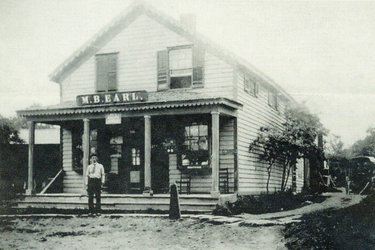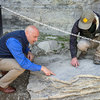Clarksville Historical Society working to preserve local past
CLARKSVILLE — The 10-year anniversary of the Clarksville Historical Society’s purchase of the former M.B. Earl general store is on the horizon.
And while there is still much to be done, much has been accomplished over the long preservation process playing out at 2074 Delaware Turnpike in Clarksville, where for nearly a half-century, Myron B. Earl ran his general store.
At the time of his death, in 1951, the Enterprise wrote that Earl “was known as Clarksville’s oldest resident.”
Marilyn Miles, the historical society’s treasurer, said her organization purchased the building in 2014.
Early in the preservation process, the project was buoyed by government grants and proceeds from the historical society's largest fundraising events, the annual Clarksville Heritage Day fundraiser, which hasn’t taken place since the pandemic started.
Clarksville, in time and place
Clarksville Heritage Day grew out of an earlier town-wide event, Plum Fest, meant to celebrate all of New Scotland — which is located “plum” in the middle of Albany County — its unincorporated hamlets, and the village of Voorheesville.
Plum Fest stopped some time ago, but its mantle was taken up by the Clarksville Historical Society in 2005 with the advent of Clarksville Heritage Day, an event informed by a century-and-a-half of history. The annual celebration is a testament to a once-vibrant past and a way to enforce a sense of identity for residents who have had that chipped away with the closure of the Clarksville Elementary School.
Clarksville thrived for a quarter-century between 1863 — when the Albany and Susquehanna Railroad “changed the economic lives of these rural families by providing a quicker and cheaper means of getting their crops to market,” according to a guide of the village archive — and 1889, when the decision was made construct a passenger depot in Voorheesville.
The new Voorheesville stop meant that passengers who previously disembarked in Clarksville and stayed in one of the hamlet’s four hotels would now be taking that business to the village, which quickly saw the construction of multiple hotels, taverns, and a grocery store.
But Clarksville didn’t become some kind of early 20th Century version of a late 20th Century Rust Belt town, a hollowed shell of a once-thriving community. “This was a very strong community,” Susan Dee, the historical society’s president, told The Enterprise in 2019, and life in the hamlet continued on for the next half-century much as it had in the decades prior to Voorheesville’s passenger depot.
It was about the middle of the century when life in Clarksville began to change, efficiently a microcosm of similar experiences had by millions of Americans in post-boom years of World War II.
Dee told The Enterprise in 2019 that sometime in the early 1950s, Clarksville began to transition into what we now know as a bedroom community. Shop owners who once lived above their stores found it made better business sense to trade in the comforts of hamlet living for the hustle and bustle of the area’s first mall, Westgate Plaza.
As the years rolled on, a collective unmooring took hold. And by 2019, with what many considered to be the heart of the community, the school, being shut down, Dee said, it was hard to identify a unifying force in Clarksville.
In March 2011, as enrollment was actually increasing in the area served by Clarksville Elementary but declining elsewhere in the district, the Bethlehem School Board, to close a million-dollar budget gap, in a split vote and against the recommendation of the superintendent at the time, decided to close the school that had served as the center of the rural hamlet since 1948. The county sheriff took over the old brick school building, which is listed on the National Register of Historic Places.
The closing of Clarksville Elementary was a blow to the community, Dee said, because, in a hamlet without defined borders or a local government body, Clarksville’s identity was deeply enmeshed with the school.
Preserving history
While the events of the past few years have put a bit of a crimp in the historical society’s plans, life under COVID hasn’t been a complete wash, Miles said; thanks to the generosity of an anonymous donor, the site hasn’t sat vacant for the past two years.
Since it took possession of the building, historical society trustee Sandy Slingerland said, the organization has focussed on the former general store’s exterior, building a new roof, and replacing large swaths of the structure’s siding.
Doors were installed in keeping with the theme of replicating “what was there before, for the last 100 years,” Slingerland said.
The front porch received quite a bit of attention, she said, but is still in need of a roof. The interior, which the historical society hopes to turn into a museum, remains largely untouched.
The organization decided a decade ago to take on the task of preserving the former general store because it is one of the “oldest of buildings in town that’s still left standing,” and,m with its prominent location within the hamlet, “it’s “right in the middle of town,” Miles said. “It just appeared to be a good building for the society to have.”
She pointed out that the building is rather unusual.
“The store in the front, an attached carriage shed, and an attached stable, and it’s all one building,” Slingerland said, “which is fairly — it’s the only one in town like that. It's kind of fairly unusual construction, I think, for buildings.”
While the historical society has property records dating back to the 1840s, it’s been unsuccessful so far in its attempt to nail down a specific date for the construction of the building.
More than a century ago, the Clarksville columnist for The Enterprise reported in 1905 that B.A. VanAlstyne re-shingled part of Earl’s store; in 1907, Ethan Allen moved in as a tenant over the store; and in 1917, Charles Dietz died very suddenly “while sitting in a chair at Earl’s store. He was 72 years old and leaves a widow, one daughter, and a brother.”
Miles did know the exact date of a 1902 Enterprise article — April 7 — announcing that “Mr. Myron B. Earl will open his new store on Saturday of this week.”



